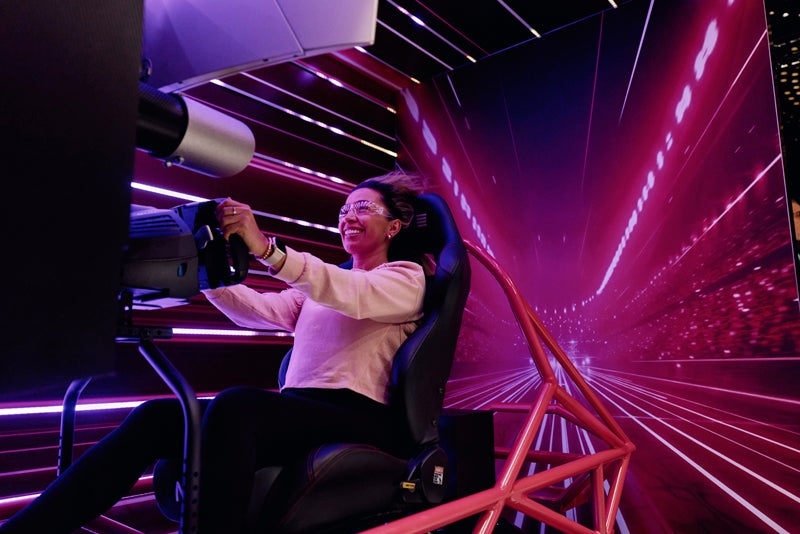It’s late. You’re tired. But you need a new dress for an important cocktail party in two days.
So you log on to the Internet and check out your favorite e-commerce sites. On the first site you see a red dress you think you like. You click and your virtual model – a computer-generated version of yourself that matches your proportions and measurements exactly – tries on the dress. It drapes OK, but the color turns out not to be you.
So you check out another site and find the proverbial little black dress. It even looks great on your “mini-me.” A couple of clicks later, and it’s being shipped to you overnight.
That scenario may sound advanced. But 3-D modeling technology – which lets products turn, open and close, or allows virtual models to try on different styles in different colors – is already being tested on several sites scheduled to be up and running for the 2000 holiday season.
The personalized images are real, not computer-generated, says Terry Gourley, vice president of business development for Marina Del Rey, CA-based consulting firm 3Dshopping.com, which offers the technology. Gourley likens it to a miniature movie made up of 32 different images in a Java format. It allows such clients as Nordstrom’s to show shoes in both horizontal and vertical formats or Hertz Furniture to let its customers arrange virtual furniture in a virtual environment (amounting to virtual rotation and virtual motion, according to Gourley). And the customer can change the size and color of clothing.
3Dshopping clients say the technology helps them sell their products.
“It really answers the customer’s questions about how things move, how they look or work, and presents the functionality of the product in a graphic, dynamic way,” says Faruk Zia, founder and designer of Galizia, which sells luggage designed to carry office equipment such as computers and printers.
Gourley estimates that the price per item being shown might be in the $300 to $500 range. A marketer with 1,000 SKUs could contain costs by using 3-D technology on one version of each item, but showing all the other colors or patterns in 2-D.
Gourley claims that some of 3Dshopping’s clients experienced a drop in return rates to about 10% as well as reductions in shipping costs. He is now looking forward to a “head-to-head test” of 2-D vs. 3-D images that will be conducted with ClickAction, a business partner. “It should give us some hard results,” says Gourley.
“Anything that gets the end user involved and interactive will increase the response rate and increase the bottom line,” adds ClickAction’s Geoff Smith.
However, 3Dshopping is not the only virtual motion and rotation player promoting the technology. Another is Fry Multimedia, New York, which recently partnered with Metastream Corp. to provide 3-D virtual imaging, motion, rotation and interactivity to such clients as Coach, Eddie Bauer and Crate & Barrel.
Why is this just starting to take off?
“What happened was that everyone was working on the technological problems,” says Matthew Mizenko, systems architect for wireless and broadband technologies at Fry Multimedia. “There were two major problems: bandwidth and modem speed.”
Essentially, available modem speed did not allow fast downloads of high-resolution 3-D images. A user could wait up to 10 minutes for one screen. Cable, DSL and faster modems have taken care of one problem from the consumer end.
In addition, the technology is now more user- friendly. The two, says Mizenko, have now met in the middle.
Fry Multimedia’s system lets the user control which parts of the images are downloaded first. The technology downloads images from the highest value to the lowest, allowing the images to be manipulated before the download is complete.
Fry Multimedia is conducting in-house tests before it redesigns any sites for its clients. Mizenko expects some client Web sites to incorporate the technology for the winter holiday season.
“The software is not all that expensive,” he says. “The cost is getting product shots. It behooves marketers to make sure they pick those products or examples that make the most sense when put into the [3-D] environment.”
Fry Multimedia partner Metastream provides a turnkey kit. The software and manual includes instructions about how to create an in-house studio with a photo turntable and a digital camera.
Yet another vendor of the technology is Public Technologies Multimedia, Montreal. It offers a product called My Virtual Model, which has been used by Lands’ End, Galeries Lafayette, Macy’s and J.C. Penney. All its clients use the application for women’s apparel.
My Virtual Model lets women create a virtual “mini-me” of themselves: a computer-generated exact twin that can try on clothes in different sizes, styles and colors, and even turn a full circle.
My Virtual Model will soon be extended to include men and young adults, according to Louise Guay, chief executive officer of Public Technologies and developer of the software. The Walt Disney Co. already uses the technology for one of its lines of children’s apparel.
“The model makes them visible,” explains Guay. “It seems to facilitate and extend the reach of the shopping experience.”
She sees such technology becoming an industry standard, which could be carried from e-commerce site to e-commerce site as the Internet customer shops. Moreover, she sees Web marketers keeping track of customers’ measurements as well and using the data to develop customer relationship management programs.
“There is great potential for loyalty programs,” she notes.
Guay also foresees chat rooms and e-commerce malls in the future where virtual models could meet and interact with other virtual models. The Internet, she explains, is as much about theater and communications as it is about the theater of commerce.
One non-clothing user of 3Dshopping’s technology is Provenance Antiques, Long Beach, CA, which offers period furniture online. “It’s the wave of the future for cars to high-ticket items,” says Aimee Miller, who founded the company three years ago with Valerie Woods. “It provides a full experience of the piece.”
Miller’s online boutique (www. 3dshopping.com/provenance/) offers French, English and American antiques from the 18th and 19th centuries. She describes her clientele as high-profile designers, collectors and celebrities. “Our market is local,” she explains. “We’re realistic about shipping.”
Often such clients don’t have the time or energy to drive out to see her inventory. And the celebrities, she explains, don’t want to be seen shopping. “They can look at their leisure at 2 a.m. and have all the information at their fingertips,” she says. The technology allows the images to be turned around and the resolution even lets the viewer see the grain of the wood. Doors and drawers can be opened and closed, lids raised and angles adjusted.
Of course, such technology is not cheap. But as a seller of period furniture that goes for five and six figures, Miller feels it more than pays for itself.



